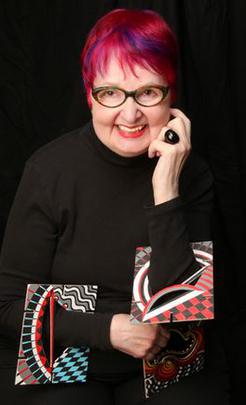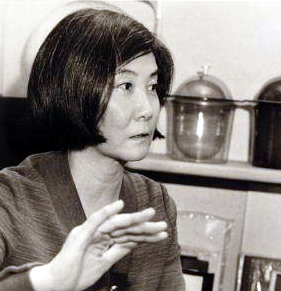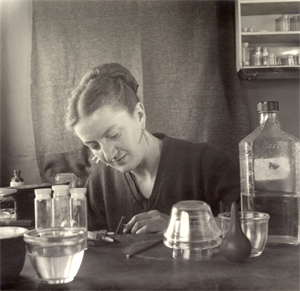
Art jewelry is one of the names given to jewelry created by studio craftspeople. As the name suggests, art jewelry emphasizes creative expression and design, and is characterized by the use of a variety of materials, often commonplace or of low economic value. In this sense, it forms a counterbalance to the use of "precious materials" in conventional or fine jewelry, where the value of the object is tied to the value of the materials from which it is made. Art jewelry is related to studio craft in other media such as glass, wood, plastics and clay; it shares beliefs and values, education and training, circumstances of production, and networks of distribution and publicity with the wider field of studio craft. Art jewelry also has links to fine art and design.
Arline Fisch is an American artist and educator. She is known for her work as a metalsmith and jeweler, pioneering the use of textile processes from crochet, knitting, plaiting, and weaving in her work in metal. She developed groundbreaking techniques for incorporating metal wire and other materials into her jewelry.
Kiff Slemmons is a contemporary American metalsmith. She received her B.A. in Art and French at the University of Iowa, but is primarily known for her career in jewelry and metals. Slemmons currently resides in Chicago, Illinois. Her work is collected by many notable museums and personalities, including the late Robin Williams.
Stanley Lechtzin is an American artist, jeweler, metalsmith and educator. He is noted for his work in electroforming and computer aided design (CAD) and computer aided manufacture (CAM). He has taught at Temple University in the Tyler School of Art and Architecture, from 1962.

Mary Lee Hu is an American artist, goldsmith, and college level educator known for using textile techniques to create intricate woven wire jewelry.
Linda MacNeil is an American abstract artist, sculptor, and jeweler. She works with glass and metal specializing in contemporary jewelry that combines metalwork with glass to create wearable sculpture. Her focus since 1975 has been sculptural objets d’art and jewelry, and she works in series. MacNeil’s jewelry is considered wearable sculpture and has been her main focus since 1996.
Gary Lee Noffke is an American artist and metalsmith. Known for versatility and originality, he is a blacksmith, coppersmith, silversmith, goldsmith, and toolmaker. He has produced gold and silver hollowware, cutlery, jewelry, and forged steelware. Noffke is noted for his technical versatility, his pioneering research into hot forging, the introduction of new alloys, and his ability to both build on and challenge traditional techniques. He has been called the metalsmith's metalsmith, a pacesetter, and a maverick. He is also an educator who has mentored an entire generation of metalsmiths. He has received numerous awards and honors. He has exhibited internationally, and his work is represented in collections around the world.
Donald Paul Tompkins (1933–1982) is an American jewelry artist known for his witty and satirical works based on objects, photo etchings, cast elements, and gemstones. He is most closely associated with the Pacific Northwest and the metalsmithing community that coalesced around Central Washington University in Ellensburg, Washington, where he taught for many years. His most famous series Commemorative Metals keenly reflected Pop Art and the artistic concerns of New York City-based artists in the 1950s and 60s.

Eleanor Moty, is an American metalsmith and jewelry artist. Her experimentation with industrial processes, such as photoetching and electroforming, was revolutionary in the field of American art jewelry in the 1960s and 1970s.
Art Jewelry Forum (AJF) is a nonprofit international organization founded in 1997 that advocates for the field of contemporary art jewelry through education, discourse, publications, grants, and awards.
Susie Ganch is a first generation American artist of Hungarian heritage. She is a sculptor, jeweler, educator, and founder and director of Radical Jewelry Makeover. Ganch received her Bachelors in Science from the University of Wisconsin-Madison in Geology in 1994 and her Masters in Fine Arts from the University of Wisconsin-Madison in 1997.
Jamie Bennett is an American artist and educator known for his enamel jewelry. Over his forty-year career, Bennett has experimented with the centuries-old process of enameling, discovered new techniques of setting, and created new colors of enamel and a matte surfaces. This has led him to be referred to as “one of the most innovative and accomplished enamellers of our time” by Ursula Ilse-Neuman, historian and former curator at the Museum of Art and Design in New York City. Bennett is closely associated with the State University of New York at New Paltz, where he studied himself as a student, and taught in the Metal department for many years. Bennett retired from teaching in 2014, after thirty years at SUNY New Paltz.
Myra Mimlitsch-Gray is an American metalsmith, artist, critic, and educator living and working in Stone Ridge, New York. Mimlitsch-Gray's work has been shown nationally at such venues as the John Michael Kohler Arts Center, Museum of the City of New York, Metropolitan Museum of Art, Cooper-Hewitt Smithsonian Design Museum, and Museum of Arts and Design. Her work has shown internationally at such venues as the Middlesbrough Institute of Modern Art, Stadtisches Museum Gottingen, and the Victoria and Albert Museum, and is held in public and private collections in the U.S, Europe, and Asia.
Linda Threadgill is an American artist whose primary emphasis is metalsmithing. Her metal work is inspired by forms of nature and the interpretations she gleans from the intricate patterns it presents. She explores the foundation of nature to allude to nature and transform it into re-imagined, stylized plants forms.

Marjorie Schick was an innovative American jewelry artist and academic who taught art for 50 years. Approaching sculptural creations, her avant-garde pieces have been widely collected. Her works form part of the permanent collections of many of the world's leading art museums, including the Hermitage Museum in Saint Petersburg, Russia; the Museum of Arts and Design in New York City; the National Museum of Modern Art in Kyoto, Japan; the Philadelphia Museum of Art in Pennsylvania; and the Victoria and Albert Museum of London.

Miye Matsukata, sometimes written as Miyé Matsukata, was a Japanese-born American jewelry designer based in Boston, Massachusetts. She was one of the founders of Atelier Janiye and later became the sole owner.

Jan Yager is an American artist who makes mixed media jewelry. She draws inspiration from both the natural world and the lived-in human environment of her neighborhood in Philadelphia, Pennsylvania, emphasizing that art is a reflection of both time and place. She has incorporated rocks, bullet casings, and crack cocaine vials into her works, and finds beauty in the resilience of urban plants that some would consider weeds.

Merry Renk, also known as Merry Renk-Curtis, was an American jewelry designer, metalsmith, sculptor and painter. In 1951, she helped to found the Metal Arts Guild (MAG), and served as its president in 1954.
Kurt J. Matzdorf, also known as Kurtheinz J. Matzdorf, was a German-born American jewelry designer, metalsmith and an educator. He was Professor Emeritus at State University of New York at New Paltz and he founded the metals department. Matzdorf was known for his religious objects in metal.
Sharon Church was an American studio jeweler, metalsmith, and educator. She is a professor emerita of the University of the Arts (Philadelphia) in Philadelphia, Pennsylvania. In 2012, Church was elected a Fellow of the American Craft Council (ACC). In 2018, she received a Lifetime Achievement Award from the Society of North American Goldsmiths.







